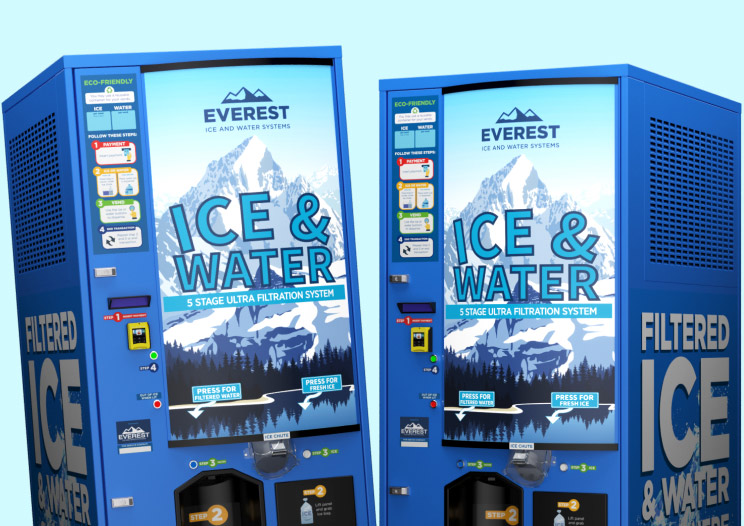Is Gas Station Ice Safe to Drink?

Buying a bag of ice at your local gas station is a common practice, whether it’s for keeping food fresh or chilling drinks for a party. But have you ever wondered just how safe that ice is to consume? Should you think twice before dropping those ice cubes into your drink? We’ll explore everything you should know about gas station ice safety.
How Safe Is Bagged Ice From Gas Stations?
The safety of bagged ice really comes down to proper handling and storage measures at each individual gas station. When best practices are followed, and the ice is properly produced, transported, and stored, bagged gas station ice is perfectly safe for human consumption.
However, there are many potential risks that can lead to contaminated ice if safety guidelines aren’t strictly enforced. Poor filtration systems, unclean storage conditions, employee mishandling, or long durations where ice sits can all impact safety. Proper ice production and stringent safety protocols must be implemented to ensure optimal purity.
What Are the Standard Procedures for Bagging Ice at Gas Stations?
Ideally, safety measures should start right at the source where bagged ice is produced. Commercial ice makers equipped with advanced water filtration systems help produce cleaner, purer ice. The ice should then be safely transported in sealed bags that have been properly handled to avoid human contact contamination on the way to its destination.
Once on site, the ice should immediately be placed in clean ice cooler bins for storage and sale to customers. If storage bins aren’t properly sanitized or maintained, this can negate earlier safety efforts in ice production and handling.
How Frequently Is the Quality of Gas Station Ice Tested?
Unfortunately, there are no enforced federal regulations around routine ice testing at gas stations or strict equipment cleaning schedules. It’s up to the discretion of each individual store to implement their own safety protocols. Some chains may have standardized corporate procedures, but many independent locations lack stringent standards or accountability around ice quality.
Without robust measures in place for filtration, handling, storage, and testing, there’s ample opportunity for contamination and compromised ice quality in gas station environments. Customers ultimately have to take cleanliness at face value or assess the quality themselves.
Factors That Can Impact the Safety of Gas Station Ice
There are a few important factors that play a role in determining how safe bagged ice may be for consumption. These include potential contamination risks, storage conditions, and the overall cleanliness of the location itself. Being aware of these aspects can help consumers make educated ice purchasing decisions.
How Can Bagged Ice Become Contaminated?
- Poor Filtration: Low-quality filtration systems allow contaminants from unclean water sources to be frozen into ice cubes
- Storage Issues: Dirty ice bins, extended storage durations causing meltwater, or poor drainage allowing bacteria growth
- Transportation Exposure: Ice bags compromised through small tears or left in unclean delivery truck beds
How Consumers Can Ensure the Ice They Purchase is Safe
When buying ice from any retail location, there are a few quick checks consumers can do to assess bagged ice safety:
- Cleanliness of Store: Customers should avoid locations with overflowing external garbage, dirty floors/walls, or pests visible anywhere on the premises. These suggest potential recurring storage bin contamination.
- Ice Bin Assessment: Quickly check that the outside housing and inside storage walls appear clean without sticky buildup or residue.
- Avoid Cracked Bags: Don’t purchase ice from torn bags that could have absorbed external contaminants from the air or cooler.
- Odor Check: Make sure the ice doesn’t have a funny smell that could indicate contamination.
Check out these additional tips for buying ice from gas stations.
Alternative Options for Safe Ice
Beyond packaged ice of questionable production and handling safety, one clear alternative exists for consumers:
How an Ice Vending Machine Can Improve Gas Station Ice Safety
Ice vending machines use an advanced filtration process to produce a steady supply of clean, fresh ice on-site. These specialty vending units first filter water (usually from the public water supply) through a multistage process to remove impurities. The purified water then feeds into a commercial-grade ice machine, which freezes fresh batches of ice throughout the day.
Portable ice makers often include additional safety features, such as antimicrobial light systems that prevent bacteria growth inside the machine without using any chemicals. These units even allow consumers to fill their own containers with bulk ice from the unit dispenser, reducing plastic waste and promoting sustainability.
When managed properly, these specialized ice merchandisers create a safer, on-demand source of pure ice. Customers seeking higher quality ice at gas stations can enjoy fresh, clean ice worry-free.
Get more operational insights into ice machines.
Offer Clean, Pure Ice to Your Customers With Everest Ice Machines
For gas stations seeking to provide optimal safety while meeting customer demand for chilled refreshments, installing an Everest Ice & Water Vending Machine delivers the best of both worlds! Everest machines lead the industry for innovation, with features like the five-stage filtration system from Everpure. This simple yet highly effective system produces pure, contaminant-free, and odor-free ice that tastes great.
Gas station owners also have the option of adding our proprietary Ice Shield technology. This cutting-edge system uses ozone to sanitize the entire ice production path down to the last cube, eliminating the risk of bacteria, mold, and other contaminants. Give parched customers peace of mind by optimizing your gas station with ice machines from Everest Ice and Water Systems.
Want to learn more about earning a passive income with clean, self-service ice machines? Contact us today!
FAQ’s
What contaminants might be in bagged ice?
Potential ice contaminants from unclean conditions include mold, viruses, chemical residues, dirt or automotive exhaust particulates, pesticide sprays, garbage odors, or even insect pieces.
Can old ice be dangerous?
Allowing bagged ice to sit for extended durations can lead to partial thawing and refreezing. This may enable bacteria propagation in melt pools beneath the ice. Old ice of uncertain age should be avoided.
What temperature should ice machines dispense ice at?
For consumable ice, 0°F (-18°C) or lower is ideal to inhibit rapid pathogen growth and limit meltwater formation.





